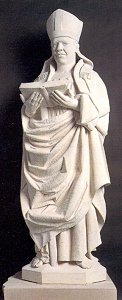Janani
Luwum
Archbishop of Uganda, Martyr
16 February 1977
 ON
6 JANUARY 1948 a young school teacher, Janani Luwum, was converted to the
charismatic Christianity of the East African Revival, in his own village
in Acoli, Uganda. At once he turned evangelist, warning against the
dangers of drink and tobacco, and, in the eyes of local authorities,
disturbing the peace. But
Luwum was undeterred by official censure. He was determined to confront
all who needed, in his eyes, to change their ways before God.
ON
6 JANUARY 1948 a young school teacher, Janani Luwum, was converted to the
charismatic Christianity of the East African Revival, in his own village
in Acoli, Uganda. At once he turned evangelist, warning against the
dangers of drink and tobacco, and, in the eyes of local authorities,
disturbing the peace. But
Luwum was undeterred by official censure. He was determined to confront
all who needed, in his eyes, to change their ways before God.
In January 1949 Luwum went to a theological college
at Buwalasi, in eastern Uganda. A year later he came back a catechist. In
1953 he returned to train for ordination. He was ordained deacon on St
Thomas’s Day, 21 December 1955, and priest a year later. His progress
was impressive: after two periods of study in England, he became principal
of Buwalasi. Then, in September 1966, he was appointed Provincial
Secretary of the Anglican Church of Uganda, Rwanda, Burundi and Boga-Zaire.
It was a difficult position to occupy, and these were anxious days. But
Luwum won a reputation for creative and active leadership, promoting a new
vision with energy and commitment. Only three years later he was
consecrated bishop of Northern Uganda, on 25 January 1969. The
congregation at the open-air Services included the prime minister of
Uganda, Milton Obote, and the Chief of Staff of the army, Idi Amin.
Amin sought power for himself. Two years later he deposed Obote in a coup. In government he ruled by intimidation, violence and corruption. Atrocities, against the Acoli and Langi people in particular, were perpetrated time and again. The Asian population was expelled in 1972. It was in the midst of such a society, in 1974, that Luwum was elected Archbishop of Uganda, Rwanda, Burundi and Boga-Zaire. He pressed ahead with the reform of his church in time to mark the centenary of the creation of the Anglican province.
But he also warned that the Church should not conform to ‘the powers of darkness’. Amin cultivated a relationship with the archbishop, arguably to acquire credibility. For his part, Luwum sought to mitigate the effects of his rule, and to plead for its victims.
The Anglican and Roman Catholic churches increasingly
worked together to frame a response to the political questions of the day.
Soon they joined with the Muslims of Uganda. On 12 February 1976 Luwum
delivered a protest to Amin against all acts of violence that were
allegedly the work of the security Services. Church leaders were summoned
to Kampala and then ordered to leave, one by one. Luwum turned to Bishop
Festo Kivengere and said, ‘They are going to kill me. I am not
afraid’. Finally alone, he was taken away and murdered. The next day,
the Ugandan government said he died in an automobile accident after
escaping from prison. After his body was returned to his home
village, bullet holes were found in the body.
The following June, about 25,000 Ugandans came to the
capital to celebrate the centennial of the first preaching of the Gospel
in their country, among the participants were many who had abandoned
Christianity, but who had returned to their Faith as a result of seeing
the courage of Archbishop Luwum and his companions in the face of death.
Amin’s state was destroyed by invading Tanzanian
forces in 1979. Amin himself fled abroad and escaped justice.
Archbishop Luwum is one of ten 20th century martyrs whose statues may be found on the west front of Westminster Abbey in London. These are intended to represent all those others who have died (and continue to die) in similar circumstances of oppression and persecution. They are drawn from every continent and many Christian denominations. They include victims of the struggle for human rights in North and South America, of the Soviet and Nazi persecutions in Europe, of religious prejudice and dictatorial rule in Africa, of fanaticism in the Indian subcontinent, of the brutalities of the Second World War in Asia and of the Cultural Revolution in China. The statues were unveiled by the Archbishop of Canterbury, in the presence of H.M. The Queen, H.R.H. The Duke of Edinburgh and church leaders and representatives from many parts of the world on 9 July 1998.
Acknowledgements:
Text adapted from Westminster
Abbey, Fallen
Martyrs, James Kiefer's Christian Biographies
Image from Westminster
Abbey